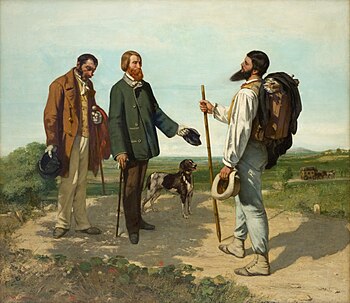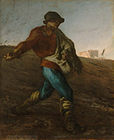Realism (arts)

Realism in the visual arts and literature is the general attempt to depict subjects as they are considered to exist in third person objective reality, without embellishment or interpretation and "in accordance with secular, empirical rules."[1] As such, the approach inherently implies a belief that such reality is ontologically independent of man's conceptual schemes, linguistic practices and beliefs, and thus can be known (or knowable) to the artist, who can in turn represent this 'reality' faithfully. As Ian Watt states, modern realism "begins from the position that truth can be discovered by the individual through the senses" and as such "it has its origins in Descartes and Locke, and received its first full formulation by Thomas Reid in the middle of the eighteenth century."[2]
In its most specific sense, Realism was an artistic movement that began in France in the 1850s, after the 1848 Revolution. These Realists positioned themselves against Romanticism, a genre dominating French literature and artwork in the late 18th and early 19th centuries. Seeking to be undistorted by personal bias, Realism believed in the ideology of objective reality and revolted against the exaggerated emotionalism of the Romantic movement. Truth and accuracy became the goals of many Realists. Many paintings depicted people at work, underscoring the changes wrought by the Industrial and Commercial Revolutions. The popularity of such 'realistic' works grew with the introduction of photography — a new visual source that created a desire for people to produce representations which look “objectively real.”
More generally, realist works of art are those that, in revealing a truth, may emphasize the ugly or sordid, such as works of social realism, regionalism, or Kitchen sink realism.
Visual arts
In general, realists render everyday characters, situations, dilemmas, and objects, all in a "true-to-life" manner. Realists tend to discard theatrical drama, lofty subjects and classical forms of art in favor of commonplace themes. The term is applied to, or used as a name for, various art movements or other groups of artists in art history. The artists at this time "told it as it is" so to speak. They drew what they had seen without any bias added. The artists simply focused on what was happening in front of them.
Literature
Broadly defined as "the faithful representation of reality",[3] was based on "objective reality", and was focused on showing everyday, quotidian activities and life, primarily among the middle or lower class society, without romantic idealization or dramatization.[4] [dead link]
While the preceding romantic era was also a reaction against the values of the Industrial Revolution, realism was in its turn a reaction to romanticism, and for this reason it is also commonly derogatorily referred as "traditional" "bourgeois realism".[5] Some writers of Victorian literature produced works of realism.[citation needed] The rigidities, conventions, and other limitations of "bourgeois realism," prompted in their turn the revolt later labeled as modernism; starting around the 1900, the driving motive of modernist literature was the criticism of the 19th-century bourgeois social order and world view, which was countered with an antirationalist, antirealist and antibourgeois program.[5][6][7]
Theatre
The achievement of realism in the theatre was to direct attention to the social and psychological problems of ordinary life. In its dramas, people emerge as victims of forces larger than themselves, as individuals confronted with a rapidly accelerating world.[8] These pioneering playwrights were unafraid to present their characters as ordinary, impotent, and unable to arrive at answers to their predicaments. This type of art represents what we see with our human eyes.
Cinema
Italian Neorealism was a cinematic movement incorporating elements of realism that developed in post-WWII Italy. Notable Neorealists included Vittorio De Sica, Luchino Visconti, and Roberto Rossellini.
Gallery
-
Jean-Baptiste Siméon Chardin, Woman Cleaning Turnips, ca. 1738, Alte Pinakothek. Chardin served as a forerunner to the movement in French painting. Chardin's influence on the art of the modern era was wide-ranging, and has been well-documented.[9]
-
Gustave Courbet, Stone-Breakers, 1849.
-
Jean-François Millet, The Sower, 1850.
-
Oswald Achenbach, Abendstimmung in der Campagna, 1850.
-
Jules Breton, The Song of the Lark, 1884
-
Eilif Peterssen, The salmon fisher, 1889.
-
Ilya Repin, They did not Expect Him, 1884-1888.
See also
- Simulated reality
- Chanson réaliste (realist song), a style of music performed in France primarily from the 1880s until the end of World War II
- Aspectism
- Pseudorealism
- Magic realism
Notes
- ^ in so far as such subjects are "explicable in terms of natural causation without resort to supernatural or divine intervention" Morris, 2003. p. 5
- ^ Watt, 1957, p.12
- ^ http://www.wsu.edu/~campbelld/amlit/realism.htm
- ^ http://www.encyclopedia.com/topic/realism_%28literature%29.aspx
- ^ a b John Barth (1979) The Literature of Replenishment, later republished in The Friday Book'(1984)'.
- ^ Gerald Graff (1975) Babbitt at the Abyss: The Social Context of Postmodern. American Fiction, TriQuarterly, No. 33 (Spring 1975), pp. 307-37; reprinted in Putz and Freese, eds., Postmodernism and American Literature.
- ^ Gerald Graff (1973) The Myth of the Postmodernist Breakthrough, TriQuarterly, 26 (Winter, 1973) 383-417; rept in The Novel Today: Contemporary Writers on Modern Fiction Malcolm Bradbury, ed., (London: Fontana, 1977); reprinted in Proza Nowa Amerykanska, ed., Szice Krytyczne (Warsaw, Poland, 1984); reprinted in Postmodernism in American Literature: A Critical Anthology, Manfred Putz and Peter Freese, eds., (Darmstadt: Thesen Verlag, 1984), 58-81.
- ^ Simard, Rodney. Postmodern Drama: Contemporary Playwrights in America and Britain. New York: UP of America, 1984.
- ^ "Without realizing he was doing it, he rejected his own time and opened the door to modernity". Rosenberg, cited by Wilkin, Karen, The Splendid Chardin, New Criterion. Requires subscription. Retrieved 15 October 2008.
- ^ National Gallery of Art
References
- Baron, Christine and Engel, Manfred, ed. (2010). Realism/Anti-Realism in 20th-Century Literature. NL: Rodopi. ISBN 978-90-420-3115-9.
{{cite book}}: CS1 maint: multiple names: editors list (link) - Morris, Pam (2003). Realism. London: Routledge. ISBN [[Special:BookSources/04152229383 |04152229383 [[Category:Articles with invalid ISBNs]]]].
{{cite book}}: Check|isbn=value: invalid character (help) - Watt, Ian (1957). The Rise of the Novel: Studies in Defoe, Richardson and Fielding. Berkeley: University of California Press.
- West, Shearer (1996). The Bullfinch Guide to Art. UK: Bloomsbury Publishing Plc. ISBN 0-8212-2137-X.

![Jean-Baptiste Siméon Chardin, Woman Cleaning Turnips, ca. 1738, Alte Pinakothek. Chardin served as a forerunner to the movement in French painting. Chardin's influence on the art of the modern era was wide-ranging, and has been well-documented.[9]](http://upload.wikimedia.org/wikipedia/commons/thumb/b/b6/Jean-Baptiste_Sim%C3%A9on_Chardin_017.jpg/112px-Jean-Baptiste_Sim%C3%A9on_Chardin_017.jpg)


![Jean-Baptiste-Camille Corot, Young Girl Reading, 1868, National Gallery of Art[10]](http://upload.wikimedia.org/wikipedia/commons/thumb/8/82/Young_Girl_Reading_by_Jean-Baptiste-Camille_Corot_c1868.jpg/140px-Young_Girl_Reading_by_Jean-Baptiste-Camille_Corot_c1868.jpg)


